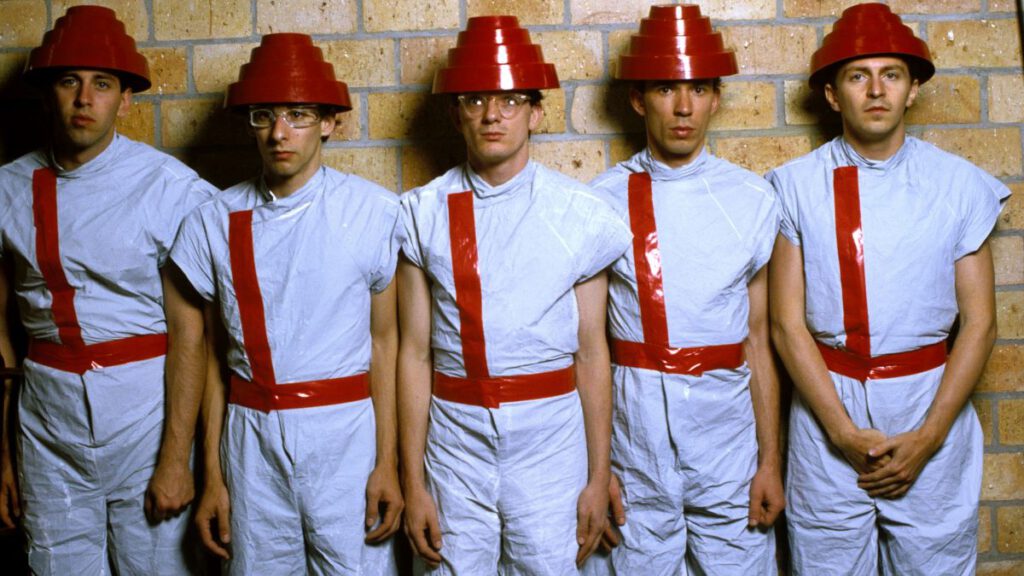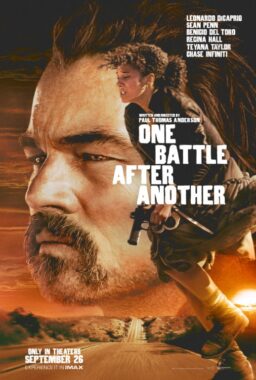Music docs have become an increasingly prominent part of the Sundance landscape, but it truly felt like the programmers for 2024 intentionally sought out films about people pushing the boundaries of the form this year. Far more than the one-hit wonder label that’s often incorrectly applied to them, Devo altered the music landscape, and not just because they gave the movie world one of its best composers. Of course, a movie about a music pioneer as inventive as Brian Eno would have to be unique itself. Finally, there’s a film that made a splash two decades ago at Sundance that has returned in an expanded form to make current rock docs look inadequate by comparison. These are all varying degrees of good-to-great, especially for fans of the artists profiled, but they could convert nearly anyone.
Those in the cult of Devo have been there for over four decades and this one is for them. Directed by the great Chris Smith (“American Movie”), “Devo” is a music doc that matches the tone and spirit of its subject, bursting with energy and creativity. After the success of “Whip It” in 1980, Devo was widely misunderstood as disposable pop rock. Smith corrects the record, chronicling how one of the most inventive bands of their era emerged from the protest movement that led to the Kent State massacre. The founding members of Devo were at Kent State at the time, radicalized further by that tragedy against the ills of this country and humankind in general, filtered through the concept of de-evolution—or DEVO.
Smith assembles the surviving members of the band, mostly focusing on the wildly talented Mark Mothersbaugh—who has gone on to be a very notable film composer for hundreds of films and TV shows, including “The Royal Tenenbaums,” “The Mitchells vs. the Machines,” and “Thor: Ragnarok”—and Jerry Casale. Smith lets the men tell their own story instead of falling victim to the common bio-doc problem in which anecdotes, hearsay and thin analysis give the entire thing a second-hand sensibility. This film feels of a piece with the Devo brand and legacy, one that really revolutionized the marriage of art and rock though their mind-blowing videos. As one of them says in the film, they were making music videos before MTV—so much so that they became a staple on the network because they had a dozen that could be in rotation.
Smith is a phenomenal filmmaker when it comes to channeling the tone of his subject through his direction whether it’s the performance art style of “Jim & Andy: The Great Beyond” or the tender appreciation of “Sr.” His “Devo” feels like more than just a chronological biography because it feels as joyous and revolutionary as the band itself. Devo melded punk, new wave, pop, and expression through video into something that felt so new. Four decades on, their legacy can be seen everywhere across the multimedia creators in the field, and those who look at the angry state of the world and wonder if evolution is going in the wrong direction.

Devo felt inspired by the creative passion of Brian Eno before they literally worked with him. The legendary member of Roxy Music and producer of Devo, David Bowie, Talking Heads, U2, and many more is profiled in one of the most unique films to ever play at Sundance. It may be simply called “Eno” but there’s nothing simple about Gary Hustwit’s experimental film, a documentary that generates itself anew every time it screens. Using a new program designed specifically for it, “Eno” blends hundreds of hours of interview and archival footage into a new form every time it plays. There are clearly tentpole scenes—comparing notes with critics at other screenings revealed this—but the montages in between, the framing of boxes in shots like the image above, and it seems many of the actual archival interviews change every time you watch it, reflecting the unusual creative process of its subject.
The approach of “Eno” isn’t just a perfect blend of form and content, but one that transcends the typical problem of a doc like this one in that Brian Eno’s work speaks for itself. Having said that, he’s a wonderfully charming interview subject, funny and open about his process. While footage of him gardening and watching YouTube clips he likes is fun, it’s the process stuff in (at least my version of) “Eno” that’s unforgettable. Watching him work with Bowie as they unpack the recording of “Heroes” or seeing a very young U2 play with the tempo of “Pride (In the Name of Love)” is the kind of granular music history that I could watch for hours.
Perhaps due to its process and its subject’s legacy, “Eno” is the rare bio-doc I wish was longer. Again, at least in my version, it feels like there are major chapters missing, but the goal here doesn’t seem comprehensive as much as reflective. Brian Eno is a genius who was unencumbered by traditional music production. Why make a traditional documentary about him?

Finally, there’s a new version of maybe the best rock doc of all time. Dave Grohl calls “Dig!” that in a new introduction to what’s being billed as “Dig! XX,” a 20th anniversary version with new narration and over a half hour of new footage. It rocks. The first movie rocked and this version rocks even harder because the truth is that I could watch the saga of the Dandy Warhols and the Brian Jonestown Massacre for hours.
Director Ondi Timoner and her brother David followed these two ‘90s counter-culture bands around for hundreds of hours, assembling the footage into the original “Dig!,” a document of rock madness built largely around the personality of Anton Newcombe, the troubled leader of BJM. As his behavior on and off the stage led to multiple collapses, the Dandy Warhols became famous with songs in commercials, TV shows, and all over MTV. It’s a stunning display of documentary editing, conveying the chaos of BJM and the ascendance of the Warhols in a captivating way. For the 20th anniversary, David went back to the original 2,500 hours and reassembled the film, even getting BJM member Joel Gion to now alternate narration with the original Courtney Taylor-Taylor, giving the film a bit more framing away from parallel arcs to the rise of one band and the fall of the other, more transparent through the gift of hindsight.
I haven’t seen the film in 20 years, but the spiral of Newcombe’s behavior feels even more dangerous in this cut than I remembered (and the reporting is that most of the new footage is of BJM). Peter Holmstrom of the Warhols says at one point, “We are a lucky band. They are a not-lucky band.” Is that really it? Is the distinction between success and failure mostly one of luck? Yes and no. It’s impossible to deny Newcombe’s self-sabotage. He’s one of the most fascinating rock personalities ever captured in a documentary, and the Timoners recognize how much he plays to the camera and hates it at the same time. In one of my favorite beats, BJM’s former manager is talking to someone about how Anton is on trial. “With who,” she asks. “That thing,” he says, pointing to the camera. Great rock docs don’t just capture a moment, they frame it, interrogate it, and maybe even place it on trial.
I was scared of the nearly 150-minute runtime when I started “Dig! XX.” I realized about halfway through that it could probably still be even longer. Maybe that could happen for “Dig! XXX.”












